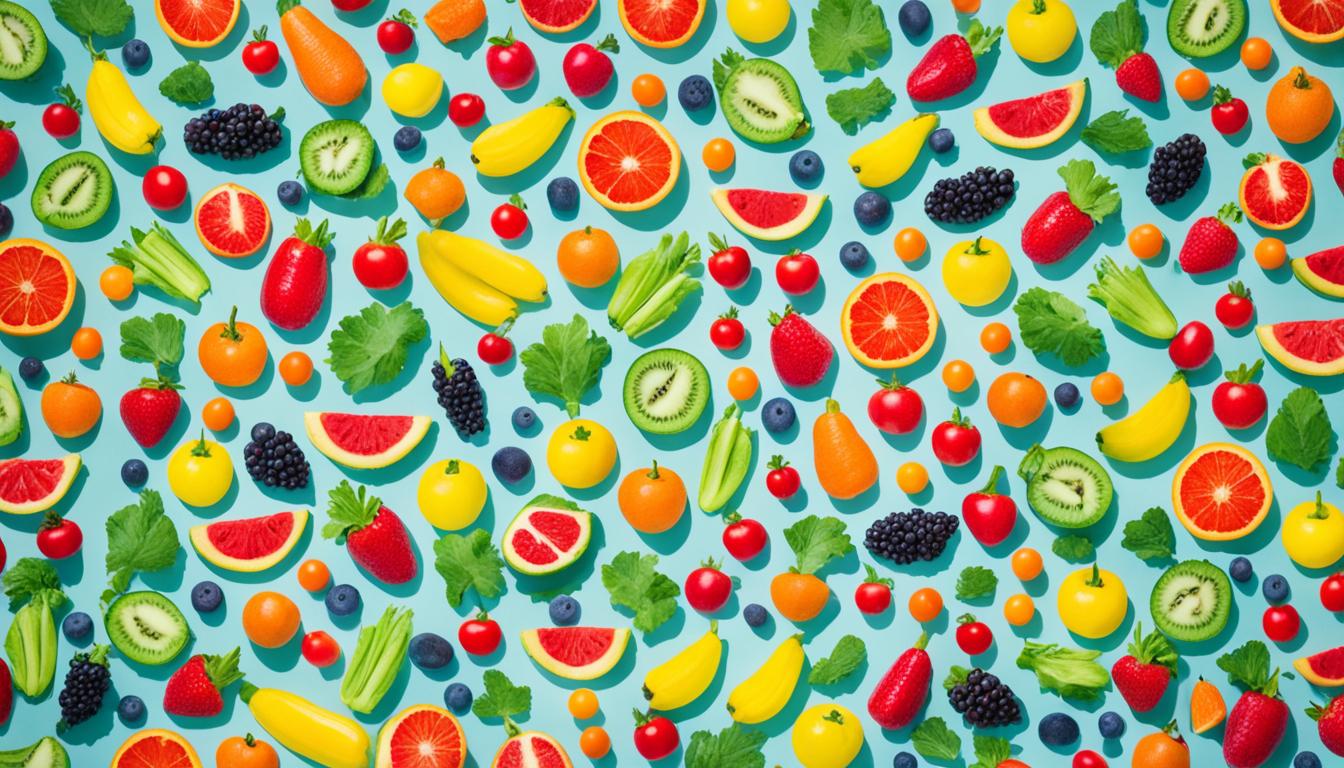
Marketing Fruits and Vegetables to Kids
SUBSCRIBE TO OUR BLOG
Promotions, new products, and recipes.
Today, many kids aren't eating enough fruits and vegetables. This raises a big question: how can we improve their diets? Fruit and vegetable marketing offers a creative solution. It combines imagination with healthy eating to make fruits and veggies exciting for kids. With fun packaging and sizes, these foods become characters in a tasty adventure. This approach helps kids see healthy eating in a new light. It also counters unhealthy food ads with creative, appealing ideas.
Key Takeaways:
- Child-directed fruit and vegetable marketing plays a key role in shaping dietary preferences and habits.
- Convenience and appealing presentations of healthy snacks can encourage healthy eating for children.
- Kid-friendly product innovations, such as snack-ready sizing, make engaging kids with healthy food more effective.
- Decision-making for children's food choices can be positively influenced by award-winning packaging designs.
- Through strategic partnerships and promotions, fruits and vegetables are becoming more integrated into children's meals outside the home.
Understanding the Impact of Food Marketing on Children
In the world of child nutrition, the power of marketing cannot be ignored. In 2006, companies spent over $1.6 billion on marketing to young people. This includes $900 million aimed specifically at kids under 12. TV, a big part of kids' lives, saw $514 million of that money.
Today, an average kid sees 13 food ads on TV every day. This high number of ads continues with little control.
The Psychology Behind Food Preferences and Advertising Influence
Junk food’s lure is no chance happening. Through creative food marketing strategies, nutrient-poor products have become more appealing than child-friendly food presentations. Take cereal companies, for instance. They market to kids cereals that contain 85% more sugar and 60% less fiber compared to those aimed at adults. This leads children to prefer snacks that are high in calories but low in nutrients, thanks to appealing packaging.
It's interesting to note that preschoolers say snacks with cartoon characters taste better than those without. This shows the strong impact of advertising on children's nutrition choices.
Transform your cooking with the latest in culinary innovation. Don’t miss out – explore our product range today!
Television and Social Media: Highways to Children's Food Choices
Fast-food companies and snack brands effectively use TV and social media to reach kids. For example, $360 million was spent on toys in children's meals in 2006. Also, an average child sees 262 fast-food ads each year. Clearly, the push to get kids into fast-food restaurants is strong.
This over-promotion of high-calorie, low-nutrient foods needs to change. We must focus more on increasing veggie intake in ads.
Alarming Trends in Childhood Obesity and Diet-Related Diseases
The impact of marketing is clear not just in sales, but in health too. Alarmingly, obesity in kids in the Americas has soared. Over 23% of boys and girls are overweight or obese. This is double what it was four decades ago.
As a result, these children are at higher risk for diseases like heart problems and diabetes. This is the consequence of targeted food advertising. There's a pressing need to change these ads to encourage healthier eating. Only $38 million was spent on promoting fruits, vegetables, and dairy. We need more focus on child-friendly food presentations and educational messages.
Creative Packaging and Presentation Strategies for Healthier Choices
Companies are making healthy snacks for kids more appealing with new ideas. They use playful packaging and sizes just right for small hands. This way, fruits and vegetables become exciting alternatives to usual snacks, featuring colorful characters and themes that engage kids with healthy food.
These designs are more than pretty; they make healthy food options for children easy and fun. We'll look at how these ideas are helping kids choose better foods and like it.
- Engaging Branding: Kids' favorite characters on packages make healthy eating fun.
- Convenience: Easy-to-eat, pre-portioned foods help busy families eat better.
- Education Through Engagement: Fun labels and names help kids learn about nutrition in a cool way.
- Colorful Variety: Bright packaging encourages kids to try all kinds of fruits and veggies.
These smart ideas are teaching kids to love fun fruit and vegetable recipes. When kids eat carrot sticks that look like astronaut food or drink smoothies with superhero logos, they start liking healthy choices more.
Creative packaging and fun presentations are important for encouraging kids to eat better. When nutritious food tells a story through its look, kids prefer it over less healthy options. The goal is clear: we need to make healthy food exciting with creativity and fun.
Encouraging Healthy Eating through Educational Initiatives
A delicious revolution is spreading in schools, turning cafeterias into classrooms and gardens into educational playgrounds. The mix of nutritional education and hands-on experiences is making students excited about healthy eating. This excitement leads to better eating habits.
Implementing Nutritional Education in School Programs
School nutrition is more than just serving food now; it's about interactive learning. Through farm-to-school activities, students gain both nutrition and agriculture knowledge. They learn where their food comes from and choose more fruits and vegetables.
This visible change comes from the new foods they're willing to try. Encouragement and exposure from school programs play a big part in this.
Parental Guidance and Involvement in Dietary Decisions
While schools teach about nutrition, parental advice on eating is very important to kids. When parents support what their kids learn in school about food, it sends a consistent, clear message about healthy eating. This teamwork helps families embrace better eating habits together, creating lasting patterns.
The Role of Advertising and Media Literacy in Nutritional Choices
Understanding food ads needs a critical look, which makes media literacy essential. It helps students see the real role of advertising in nutrition and make smart choices. Schools focusing on this are preparing students to ignore misleading ads and become smart eaters.
Combining efforts from schools, parents, and media literacy promises a healthy future for our kids. Below is a table showing how these efforts help:
| Initiative | Impact on Students |
|---|---|
| Farm-to-School Programs | Increased nutritional knowledge, greater willingness to try new foods, higher fruit and vegetable consumption |
| School Garden Programs | Boosted nutrition knowledge, eagerness to taste fruits and vegetables, positive attitudes toward healthy foods |
| Cafeteria as Learning Labs | Exposure to new foods, promotion of balanced meals, encouragement to try unfamiliar foods with taste tests |
By creating school gardens, students can see their food grow and enjoy the results of their work. A mix of gardening, cafeteria labs, and farm visits shows how well educational programs can shape eating habits. Adding school nutrition education into daily lessons ensures our kids grow up valuing a nutritious diet.
Engaging Kids with Fruits and Vegetables Through Interactive Content
Understanding the importance of a balanced diet in a child's growth is key. The real challenge is in making healthy options fun. By using storytelling in food marketing, the colorful plate method, and edible garden projects, we can make learning about nutrition exciting. Adding educational games and apps for healthy eating can really help a child get interested in what they eat.
Fun Fruit and Vegetable Recipes to Make Together
Getting kids to cook with you can start great eating habits. Making yummy and pretty dishes can lead kids to love healthy food. Kids Corner has fun activities like puzzles and coloring sheets. They make learning about different foods fun while you cook.
Using Storytelling and Games to Teach About Healthy Eating
Kids love stories and games naturally. These can be strong tools for teaching about eating right. Digital tools from USDA Team Nutrition make learning fun with games like 'Blast Off' and 'Track and Field Fuel-Up'. These tools put nutrition in terms kids love and follow, with characters like Captain Create making healthy living exciting.
Edible Garden Projects: Sowing the Seeds of Nutritional Knowledge
Learning by doing in garden projects teaches kids where food comes from. Programs like Color Me Healthy teach kids to love fresh food. Helping in their own garden makes kids want to try and like different foods more.
| Activity | Description | Impact on Healthy Eating Habits |
|---|---|---|
| Discover MyPlate: Emergent Reader Mini Books | Interactive reading materials for kids | Builds literacy skills and nutritional knowledge simultaneously |
| BAM! Dining Decisions App | Game on devices for making healthy food choices | Empowers independent, health-conscious decisions |
| Make Sun S’mores with Solar Oven | Hands-on project using the sun’s heat to cook | Teaches about solar energy and cooking with natural resources |
| Outbreak Squad Game | Educational game for older kids about food safety | Raises awareness about foodborne illnesses and prevention methods |
By using these interactive methods, we can tell a story about healthy eating that kids will love. It's not just about teaching them what to eat, but making it enjoyable. When kids take part in making meals or learn through playing, they are more willing to eat fruits and vegetables.
Conclusion
We need to focus on stopping childhood obesity and encouraging good eating habits. This is especially true as only 55% of people have enough fruits and vegetables. Marketing healthy eating to kids is crucial. By 2050, 1.5 billion more people might lack access to these key foods. This threatens the health of future generations unless we act now.
The power of fruits and veggies in fighting health problems is often ignored. Roughly a third of the food the world produces is wasted. Since agriculture uses almost half the planet’s vegetated land, changing our diet matters. Eating less beef could save land and help our planet and food supply.
There’s hope in solving these big problems. Teaching kids to enjoy healthy foods early makes a big difference. Leading by example and educating the public can improve health. It’s important to keep talking about nutrition. It matters for everyone around the world and right at home. Parents, teachers, and kids all have a role to play in shaping a healthier future.
FAQ
How does marketing influence children's preference for fruits and vegetables?
Marketing really matters when it comes to what foods kids want. It uses cool tools, like catchy packages and favorite cartoon characters. These fun touches help fruits and vegetables stand out. They get kids excited about healthy snacks just as much as junk food.
What psychological tactics do advertisers use to influence children's eating habits?
Advertisers know how to catch kids' eyes with excitement and the promise of fun. They create ads that make children want certain foods so badly, they'll ask their parents for them. This approach, along with smart product placements and fun online content, pushes kids towards unhealthy foods. It's key to guide these ads to promote healthy eating instead.
How does exposure to food advertising on television and social media affect children?
Kids see lots of food ads on TV and online, and most of these ads are for junk food. This constant advertising makes kids want and eat more of these foods. It's a big reason why unhealthy eating habits and obesity are on the rise among young people.
Why is nutritional education important in schools and at home?
Learning about nutrition in school shows kids why fruits and veggies are good for them. It introduces them to healthy foods. At home, when parents show and tell their kids about healthy eating, it makes a big difference. Knowing about ads and why they push certain foods helps kids make smarter food choices.
What creative strategies can be used to make fruits and vegetables appealing to kids?
Making fruits and veggies fun is key. This can be through food art or adding them to dishes kids love. Fun recipes, stories about eating healthy, and games about food keep kids engaged. Growing food in an edible garden is also a great, active way to learn and eat healthily.
How can parents involve their children in healthy eating habits?
Parents can get kids in the kitchen to help make meals. This makes kids more excited about what they're eating. Using the "colorful plate" method adds variety. Sharing food stories and playing nutrition games enhances learning. Creating fun food content together can spark a child’s interest in healthy eating.
What are some ways to overcome picky eating in children?
To help picky eaters, offer lots of healthy foods without pressuring them. Getting kids involved in choosing and preparing meals is crucial. Serving food in fun ways and staying positive, even when they say no, helps. Using educational content can also widen their taste for different fruits and veggies.
Can edible garden projects really help kids eat more fruits and vegetables?
Absolutely, edible gardens are a great learning tool. Kids get excited about the food they've grown. This makes them more open to trying new fruits and veggies. It leads to better eating habits.
How can nutritional education be effectively implemented in school programs?
Schools should weave lessons on fruits and veggies into everyday learning. Offering tasty, healthy options in the cafeteria is important. Starting a garden project can add to the fun. Teachers, parents, and students should work together. This reinforces healthy eating habits both in school and at home.
What role does media literacy play in children's nutritional choices?
Media literacy teaches kids to think critically about ads they see. Ads often push junk food. Understanding these ads' goals helps kids choose healthier foods over catchy advertisements. This makes kids smarter eaters in a world full of ads.
Source Links
- https://www.cbc.ca/news/business/fruits-vegetables-kids-marketing-packaging-1.4110785
- https://www.obesityaction.org/resources/food-marketing-to-children-a-wolf-in-sheeps-clothing/
- https://www.cdc.gov/pcd/issues/2011/sep/10_0272.htm
- https://www.who.int/news/item/03-07-2023-who-recommends-stronger-policies-to-protect-children-from-the-harmful-impact-of-food-marketing
Well That's the Story. I hope it was helpful. Let's Hear Your Thoughts!
We've shared our insights, and now it's your turn! Have an opinion, a question, or a story to share about this article? Dive into the comments below and join the conversation. Your voice is a crucial part of this community, and we're eager to hear what you have to say.
Thought that was fascinating? Here’s another story you might like:
See: The Hydrocolloid Glossary
For further reading:
Hero Ingredients: How Hero Components are Shaping Food Choices in 2024
Every dish deserves the perfect texture to complement its flavors. Why settle for anything less than perfection? With Cape Crystal Brands Food Texture products, you don't have to. Whether you're crafting velvety sauces, glistening gels, or fluffy mousses, our range ensures you get the consistency you desire every single time.
Don't just cook—create masterpieces. Dive into the world of culinary textures and elevate every meal. Shop now and experience the magic of Cape Crystal!
🛍️ Click Here to Explore Cape Crystal Brands Food Texture Products!

Chef Edmund
Edmund McCormick is the founder of Cape Crystal Brands and EnvironMolds LLC. He is the author of several non-fiction “How-to” books, past publisher of the ArtMolds Journal Magazine, editor of Beginner's Guide to Hydrocolloids, and author of six eBook recipe books available for download on this site. He resides in Far Hill, NJ and lives and breathes his food blogs as both writer and editor. You can follow him on Twitter and Linkedin.
- Choosing a selection results in a full page refresh.





